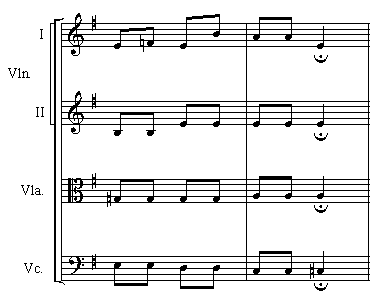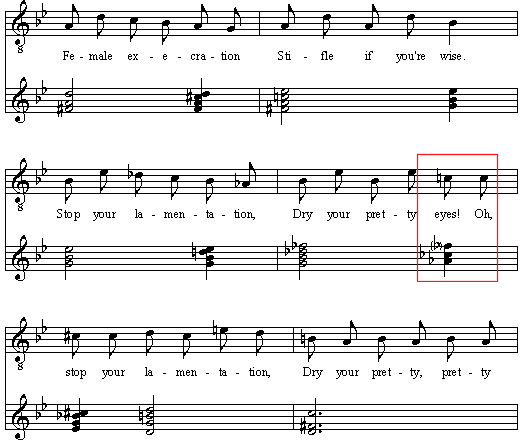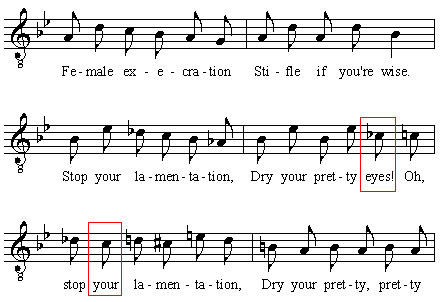 |
 |
||||||
ERRATA LIST FOR THE CHAPPELL VOCAL SCORE
OF PRINCESS IDA
1. ERRORS/ISSUES IN THE VOCAL PARTS
SP: 30/1/5 |
Alto: The alto line vanishes in this bar (on "But your doing"), and also in the analogous bar of the second verse ("We will hang you"). The obvious solution is to have the altos sing with the sopranos for those four notes. However, there is no apparent musical reason for the sudden change from four-part to three-part harmony, and it's possible Sullivan intended a separate line. Marc Shepherd's autograph copy shows evidence of the existence of such a line, but it may have either been crossed out (whether by Sullivan's or a later hand cannot be determined) or altered in some illegible way. According to Larry Byler's orchestra parts, the strings harmonize this passage as follows: [Note: The viola's second G# may be erroneous. Apart from the suspect viola note, the Violin 1, Viola and Cello parts exactly match what is written for Soprano, Tenor and Bass. So it seems to me self-evident that the Violin 2 part corresponds to what the Altos should sing: B-B-E-E. This line balances the bass part perfectly: both parts contain two separate notes in that measure, the first sung twice on beat 1 and the second sung twice on beat 2 (BB and EE for the altos, EE and DD for the basses). It fills in the holes in the harmony, and makes the alto part less disjunct, avoiding the awkward leap of a fifth between the two measures from melody to harmony. I think it would be a perfectly valid musical decision to add those notes to the Alto part. |
SP: 30/1/5 |
Tenor, n2: See the issue for SP: 29/3/6 (LP: 42/4/4) under "Errors/Issues in the Piano Part" for a possible issue for the tenors. |
SP: 31/4/1 |
Hilarion: This bar contains five beats instead of four, though there's no meter change indicated. Perhaps unimportant since it's a free recitative, but it looks like an error. Probably the third syllable of "Florian" should be an eighth note instead of a quarter, and the following quarter rest should be an eighth rest. It would be an easy enough misprint to make, with the old-style quarter rests. |
SP: 37/3/3 |
Principals: The lengthy voice assignments for this section are confusing and unnecessary, since everyone sings in unison anyway. Placing Cyril and Hilarion in the upper staff with the Girls causes a possible misreading on the final "pum-pum" at the end of the section. Cyril is directed to sing with the Altos, Hilarion with the Tenors. Since Cyril has presumably not been singing in the soprano range for the entire section, he is likely to sing the F-E notes down an octave from the rest of the Altos, which would make for very bad voice-leading (as he'd be singing the 4-3 resolution below the dominant note sung by the Basses). The intention is obviously that he would sing the bulk of the section in "tenor" clef (in his own octave), and jump up to actual treble clef for the last two notes. (This is, in fact, spelled out clearly in the second verse.) Hilarion, meanwhile, is likely to get lost (in the first read-through, at least), as he'll be watching the top staff for most of the section, then have to make a sudden visual shift to the lower staff for the last two notes, not to mention a very hasty transposition to bass clef. He might as well read the Chorus Tenors' line throughout, since this is in fact exactly what he sings. Gama is left out of the final two-note assignation process. Surely he sings along with the basses (unless the tenors need strengthening, and he has the note). |
SP: 40/2/1 |
Tenors, n2, 4: Although the chorus Tenors have middle C, Cyril and Hilarion are given E in their separate staff. The balance seems strange, since all other soloists double the chorus. It seems as though the extra solo staves (Hild. & Florian for some reason appearing above rather than below Cyril & Hilarion) are there only to specify that the solo tenors sing the entire upward scale on "till that time you'll here remain," which in the chorus is broken up between Basses and Tenors. It's possible that the solo E notes are deliberate, but it seems more probable that the E notes were accidentally omitted from the chorus part. Note that the doubled middle C's on "And" and "Should" ("And bail we will not entertain, Should…") have double stems in both iterations of this section (except in LP, in which one of them was omitted), while "our/his" and the second syllable of "mandate" have only down stems. My guess is that the chorus should double Hilarion's part on these two notes, as also shown in the left hand piano part. This would also apply to the repeat. On this issue, Marc Shepherd adds: "The vocal score is faithful to the autograph, but I agree it is peculiar. Given the haste in which he sometimes worked, this is the kind of mistake Sullivan could easily make." |
SP: 58/2/3 |
Cyril, n5: SP has the original "And the niggers they'll be bleaching" lyrics. LP has the less offensive but mostly meaningless lyrics: "And they'll practise what they're preaching." I prefer Isaac Asimov's suggestion: "And the ravens they'll be bleaching." |
SP: 71/4/2 |
Psyche, n6: Beginning with the first syllable of "Darwinian," the license copy and first-edition libretto differ from the score, the line being given as "While a man, however well-behav'd…" That version is probably the more easily singable of the two. The same change, if adopted, would be made to the ensemble repetition of the phrase. Paul Howarth of Savoynet informs me that he owns a 19th-century Chappell score which contains the altered line. (Meaning, incidentally, that there is yet another score in existence which could possibly shed further light on some of the errata in this list, should someone — and I cannot emphasize this overmuch — someone other than myself wish to do the work!) However, speaking in favor of the "Darwinian" version of the line, Marc Shepherd comments: "In the first published British libretto, the line was: 'While a man, however well-behaved' The prompt copy in the Gilbert papers, matched by the oldest surviving D'Oyly Carte prompt book, changes it to: 'While Darwinian man, though well-behaved' There is therefore, in my mind, no doubt that the last of these is the version G & S settled on." |
SP: 91/2/2 |
Cyril, n6: The lyrics should probably be "of shame," as usual, rather than "for shame." Some editions of the libretto have "for shame" in the second verse, but the libretto text does not include the musical repetition; the first verse has "of" once, and the second verse has "for" once. In the score, the first verse has "of" twice, but the second verse has "of" the first time and "for" the second time, which makes no sense. Most singers tend to stick with "of " all the way through, which seems the best choice. |
SP: 99/1/5 |
Men's chorus, n5-6: The C note on "eyes, O" is harmonically at odds with the orchestra, creating a garish dissonance with the E major harmony established in the orchestration in the women-only section, which is repeated literally here. This is perhaps the most difficult issue to resolve in the entire score, as the autograph and parts confirm the presence of the dissonance, which is more extreme than any other single harmony known to me in Sullivan's works. Marc Shepherd tells me that the late Bruce Miller, a highly respected G&S musicologist and scholar, once commented that this passage was " the most harmonically adventurous music Sullivan wrote for the Savoy." I agree entirely with that statement. Even overlooking the presence of that one dissonance (which I contend is an error rather than a harmonic adventure), the passage is one of extraordinary harmonic complexity. Here is an overview of the melody and harmony of the passage:
There are a number of startling dissonances is this passage, other than the one I have already pointed out. The C# sung by the women (coinciding with the last two syllables of the men's "execration") is set against the prevailing D major harmony, creating a moment of harmonic tension which demands resolution. At the same moment that it resolves to C-natural, however, the D in the orchestra moves up to Eb, altering what would have been a dominant seventh chord (D7) to a diminished chord, upping the harmonic tension another notch. The tension is increased still further by the D which the men continue to sing on the offbeats, as though the expected D7 chord were in fact being played. Then, when the ear is being irresistibly drawn to a G minor resolution, Sullivan sidesteps the expected cadence and shifts upward to Eb major, first inversion. In the next two bars, this extraordinary sequence is repeated verbatim, up a half step. However, it is at this point that we come up against the inexplicable dissonance that I've highlighted in the notation above. All the other dissonances in the passages, though unusual for Sullivan, are readily explained in terms of conventional harmony. The dissonances are momentary, and resolve stepwise into the succeeding harmonies in analyzable ways. Only this one dissonance makes no apparent sense, because the C is approached from a note which is already dissonant within its own chord (Eb on the second syllable of "pretty," set against a Gdim7 chord), the C itself is starkly at odds with the E major chord which accompanies it, and although the note it finally "resolves" to is in fact part of the accompanying chord, the chord itself is one of extreme tension (a "German sixth" chord on Eb), requiring a further resolution to G major, second inversion. So we end up with a jarring dissonance with no harmonic "closure," and in place of a satisfying resolution we get a disjunct harmonic shift to an unrelated and unstable chord. I cannot convince myself that Sullivan really intended this, despite the fact that the men's parts (and indeed the trombone and cornet parts which double the men's chorus) are written out in their entirety in the autograph, rather than with an abbreviated sign indicating a literal repeat of the previous section (which would better support the theory that Sullivan's pen had slipped). Apparently Sir Malcolm Sargent shared my skepticism, for on the 1965 D'Oyly Carte recording this passage is sung approximately as follows:
Here, the initial C note (on "eyes") is altered to C-flat, allowing the harmony to work correctly on the downbeat (where the dissonance is most painful), while the C-natural on the next note acts as a passing tone to the next harmony. (According to Larry Byler, this change is also made in the 1955 DOC recording.) The note on "your" ("stop your lamentation") is also altered in the recording, making an interesting upward sequence of descending seconds not contained in the original line. I can see no harmonic justification for the latter change, and am curious as to how it came about. However, to my mind, the change from C to C-flat on the downbeat is essential to preserve the phrase's harmonic integrity. It's a very difficult call to make, given the amount of contradictory evidence in the autograph. Perhaps further scholarship will uncover a later correction not shown there, which supports the performance in the two recordings. It would be far too much of a liberty to state categorically that the autograph is wrong. But to my mind the C-natural simply does not work, even as an accented passing tone. The clash of harmonies is too great, even given the clash of arms occurring at this point in the plot! Bear in mind that making this change for the men's chorus also entails an equivalent change in the cornet and trombone parts for this measure. Additionally, if the music director wishes to keep the phrase consistent with the men's first entrance, the cornet, trombone and oboe parts will need to be altered at that point as well. One final detail from the recording that I'm somewhat reluctant to mention is that the men's chorus appears to be flatting the C on the second syllable of "lamentation" (in the double-chorus section only), as well as on "eyes."
I may be mishearing this detail, or it may be an error on the chorus's part. It strikes me, however, as a fairly reasonable idea, since the C-flat gives an appropriately minor inflection to the word "lamentation" and, by matching the C-flat on "eyes", makes the entire phrase easier to sing. However, it must be admitted that all these alterations amount in sum to a quite significant rewriting of Sullivan's score, and that once you begin this sort of thing it becomes very difficult to know where to stop. Until a more scholarly solution is arrived at, each music director will need to decide for him/herself how much liberty we are entitled to take in this way, if any. |
SP: 110/3/1 |
Tenors, n1-2: Tenors sing C for the first two beats of this bar, but in the previous identical section they sang A-flat on beats 1-2 before going up to C on beat 3. There's no apparent reason for this change, but the autograph confirms that it's the way Sullivan wrote it. Tenors (and music directors) should take note of the difference. |
SP: 110/3/3 |
Tenors, n1-2: Similar issue. Previous section had B-flat on n1-2, this section has D throughout the bar. Sullivan may have erred, of course, and if the music director prefers to keep the two phrases consistent, it would do the passage no harm (and would be easier for the tenors to remember). However, it can't strictly be called an erratum. |
SP: 113/4/4 |
Sopranos, n1: The note on "blow," ending the phrase, is a quarter note here. Of the six cadential notes ending the three sets of "blow/foe" phrases, the first three (blow/foe/blow) are written as quarter notes, and the last three (foe/blow/foe) as half notes. There's no obvious musical reason for the change. But again, the autograph confirms the inconsistency. Marc Shepherd comments: "It’s probably something that, had he thought about it, Sullivan would have agreed should be consistent. But he didn’t write it that way." |
SP: 126/2/3 |
Basses, n2: On the recording, the basses sing F# (a third higher than printed). Although this does seem the more musical choice, the autograph confirms that the printed D is correct. |
SP: 130/2/3 |
Arac, n7: The eighth-note flag is missing (on "Who"). |
SP: 131/4/3 |
Guron, n5: The usual upper G note option is missing. It's present in verses 1-2. |
SP: 133/1/1 |
Chorus: At this point, a notational shorthand was adopted in SP. The entire chorus is written in two-part harmony, doubled at the octave by the men and women's choruses. On the previous page, the parts were written in treble and bass clefs, with both voice parts printed in both clefs. At 133/1/1 (the top of the page in SP), the bass clef is changed (with no courtesy clef change in the previous bar) to treble clef, and only one voice part per clef is printed (higher notes in the top staff, lower notes in the bottom staff). By way of explanation, the staves are marked "1st Sopranos & Tenors" and "2nd Sopranos & Basses." This is an awkward though not unreadable change; the basses are suddenly reading in treble clef, in mid-phrase, while tenors and 2nd sopranos have to shift their gaze suddenly from one staff to the other. No space is saved on the page by this change; the only advantage was to the engraver, who had fewer notes to set. In LP, this change looks particularly clumsy, as it occurs in mid-system rather than at the top of a page, making the sudden change appear completely inexplicable. It's a regrettable instance of the lack of original thinking which characterizes that edition. |
SP: 136/3/1 |
Hilarion, n2: Although "hours" is divided into two notes (an eighth and a quarter), it could arguably be sung as three eighths, in the same way that Cyril sang "This bold in-TRU-U-SION" in the Act 1 Finale. Thus, the syllabification of "HO-OU-RS" would match that of "SHO-OW-ERS" and "FLO-OW-ERS" in the preceding two bars. However, the final "hours" (two bars later) should be sung, as written, with one syllable. |
| < Previous Section | Next Section > |
Page modified 14 August 2019



